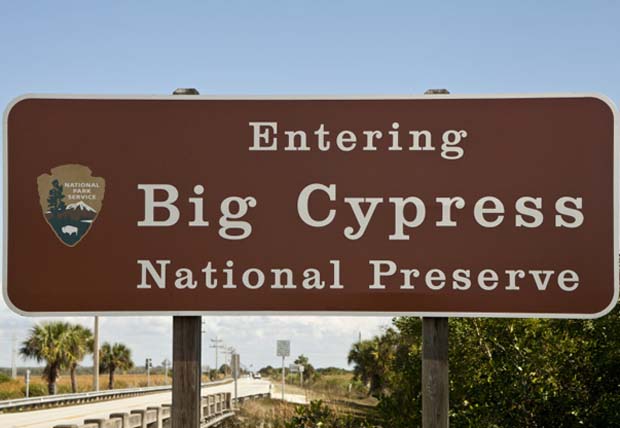[dropcap]I[/dropcap]usually end my snook forays to the Tamiami Trail (RTE 41 connecting Miami to Florida’s west coast) by May, but I’d gotten a second hand report that the snook bite along the western “Trail” was still good – even though the water would usually be too worm in late June. As it turned out there had been a lot of rain west of my Ft. Lauderdale digs.

Part of the Trail borders Big Cypress National Preserve. Some of the best winter tarpon fishing is found right behind the Big Cypress headquarters on the “Trail.”
The water was fresh and cool and my cockamamy tide calculations – usually off by a few hours, were spot on. The tide was just starting to fall. It can be tough to get tides right on the ‘Trail” because of wind direction, water releases by South Florida Water Management District folks and rainfall in the Everglades. I’d decided to go retro and fly fish with a dropper. I hadn’t done that since leaving Pittsburgh some 23 years ago.
I brought three rods, the short Sage Bass Rod, a SouthFork Rods built three piece 7-weight and an ECHO 9-weight. The latter for insurance in case the tarpon were around.
Fishing the western “Trail” is mostly fishing a canal system that parallels it on the north side (mostly) and runs from just east of Everglades City (junction Rte 29 off of I-75 ) to the Big Cypress Preserve headquarters and west to Marco Island with a fishable cut-off option to Goodland, Florida. Scouting the usual snook haunts takes time and is well worth the process, which was taught to me by the Land Captain, Steve Kantner.
My Sage was ready for action – including a dropper about 2-plus-feet long (30-pound test) and 4-feet up the leader, which was a total of 10-feet long including a 1-foot long shock of 30-pound mono. The end of the leader fly was a big, sloppily tied polar-fiber minnow – 3-inches long and the dropper a 1/0 white Deciever. Match the hatch? No.
Note: I tie a single line to the Dropper using a Perfection Knot for a loop to loop connection.
On my third stop, I heard a crashing snook, but the bank over-growth concealed the fish and prohibited a cast. I backed down to an opening and stepped in water up to my knees – a few more steps in and I’d be over my head. First cast of the day was short of where I guessed the crasher had been feeding, and too far to the right, but I stayed with the cast. I let the flies settle, then short jerks with the rod tip in the water – halfway in – BAM. I was able to keep it from the mangrove roots and landed and released in water a nice 5-pounder (guessed). I’m not a lip-lock fan if I’m releasing and I don’t take fish out of the water if I’m releasing. The snook had grabbed the dropper. As the tide progressed, my snook scorecard read five and all but one had bit on the dropper – none bigger than my first. I’d switched to the 7-weight after three fish because where I ended up fishing provided plenty of long back cast privileges.
One more stop at a secret tarpon spot, and sure enough – they were there. Lots of them. I decided to go with the dropper and accordingly rigged up my ECHO nine with a 12-foot leader that had a 2-foot shock of 50-pound mono. The dropper was 4-feet up the line and 2-feet long and was 50-pound test (see note). My fly choice was 1/0 white Deceiver and the dropper fly was a 2/0 yellow-green Deceiver with a lot of flash.
Note: I tie a single line to the Dropper using a Perfection Knot for a loop to loop connection.
On my third or fourth cast, which was still proving to be a bit awkward because of the weight of the flies, made only the middle of the canal, not the far bank. In moving water, you need to quarter the retrieve from the far bank (in this case) into deeper water – like trout and steelie fishing. Before starting a quartering retrieve, I let the strong current take the fly toward where I had wanted to place it. Two or three pulls and BAM – BAM. Two tarpon simultaneously go airbone and the big one stays hooked. In about eight minutes I was releasing the ‘poon in the water. A nice 15-pound dark backed tarpon. It had taken the dropper and punished the fly. Change-out required.
Eight tarpon later (jumped maybe 20 – dropper knot failed twice – I learned you really have to snug the knot down tight) the bite was over, it was getting dark, thunder and lightning just a few miles away, and the mosquitoes were having a sit down dinner on me. I called it a day.
The biggest tarpon landed was maybe 20-pounds. The biggest was over 30-pounds. All but one had decided on the dropper and that one took the fly as soon as it hit the water. My fishing range was just about a football field long. The action was none stop for close to two hours.
I’m now a Dropper Loop fan – is it the action in water or commotion that makes the difference? Or was it just one of those unforgettable days? Maybe I’ll find out when I go snookin’ in the surf.


